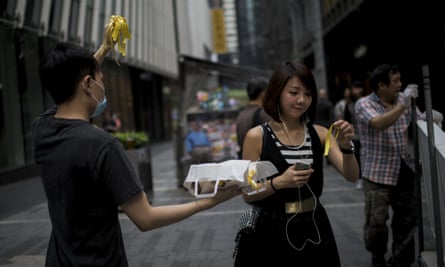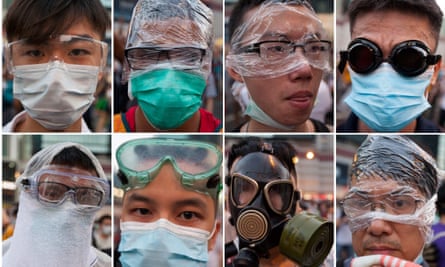What’s the story?
Hong Kong, one of the world’s most important financial hubs, has exploded into protest. Since Sunday night, the so-called “umbrella revolution” has turned the city’s gleaming central business district into a virtual conflict zone, replete with shouting mobs, police in riot gear, and clouds of tear gas. Tens of thousands of Hong Kong residents – young and old, rich and poor – have peacefully occupied major thoroughfares across the city, shuttering businesses and bringing traffic to a halt. They claim that Beijing reneged on an agreement to grant them open elections by 2017, and demand “true universal suffrage”. Organisers said on Monday that the protest would not end until Beijing changes its electoral guidelines and Leung Chun-Ying, the city’s pro-Beijing chief executive, steps down. Neither side seems prepared to back off, and nobody knows how the standoff will end.
How this happened
Hong Kong, a former British colony of 7 million people, has been governed under a “one country, two systems” framework since it was handed back to Chinese control in 1997. The principle is simple in theory — Beijing is responsible for the city’s defence and foreign affairs; Hong Kong enjoys limited self-governance and civil liberties, including an independent judiciary and unrestricted press.
Its top political post – that of chief executive – is chosen by a “nominating committee” of 1,200 people, most of them from pro-Beijing elites. Yet when Beijing regained control over the city, it promised that the region would be able to elect its top leader by universal suffrage by 2017. The group guiding the current protests – set up 18 months ago by two professors and a baptist minister under the banner Occupy Central with Love and Peace — threatened to paralyse the city’s central business district if Beijing broke its word.

Nobody knew when, or if, the protest would occur, but in August Beijing passed a reform framework to stipulate universal suffrage on its own terms – only two or three committee-vetted candidates who “love the country” would be allowed to run. Activists considered this the last straw. Students began a class boycott last Monday and, galvanised by a city-wide surge in support, staged a large-scale protest outside of the city government headquarters on Friday night. Occupy Central mobilised on Sunday. The rest is unfolding as you read.
The issues
Will Hong Kong get democracy?
Probably not. Top Communist party officials have put their full weight behind the proposal for committee-vetted candidates, and have shown no sign that they’ll be willing to heed protesters’ demands. Above all, Beijing fears that the city, if left to its own devices, would choose a pro-democratic candidate, potentially planting the seeds for a movement to break away from mainland control. And for a leadership already grappling with separatist movements in the western regions Tibet and Xinjiang, any sort of successful independence movement would set an unthinkable precedent.
Relations with Beijing
The civil disobedience campaign is about more than open elections – it’s about the future of the city’s relationship with Beijing. Hong Kong residents say that over the past few years, the central government has been slowly and systematically tightening its grip over the city, leading them to feel politically marginalised and economically squeezed. Real estate markets have flooded with mainland money, making home ownership prohibitively expensive. Local media outlets have begun to rigorously self-censor, for fear of losing advertisers. Outspoken voices have been threatened, even attacked.

Echoes of Tiananmen
The main question burning in the minds of most Hong Kongers is how this will all end – and almost everyone involved can surmise a worst-case scenario. Hong Kong’s former security chief Regina Ip said on Monday that the city government fears a “mini-Tiananmen” – presumably that the protests would be violently dispersed, perhaps by the Chinese military. Nobody wants to see a repeat of 4 June 1989, when Beijing dispatched the People’s Liberation Army (PLA) to open fire on peaceful pro-democracy protesters. The PLA maintains a garrison in Hong Kong, but Leung said in a televised address on Monday morning that the Hong Kong government would not call in the troops. Chinese state media has also emphasised the central government’s confidence in Hong Kong authorities to deal with the protests themselves. That said, the protests continue to escalate, and Beijing seems ready to stand its ground, no matter what the cost.
The view from the mainland
While the blanket censorship makes it difficult to assess public sentiment towards the protest (state media has taken a hardline on the protests and censors blocked or scrubbed clean social media, mainland citizens have responded to past Hong Kong demonstrations with a mixture of puzzlement, envy and disdain. Similar protests on the mainland would be unthinkable – even organisers of seemingly benign demonstrations are subject to extreme intimidation, even prosecution. Mainstream Chinese society holds economic growth and social stability as sacrosanct, and many mainlanders wonder why a city which benefits tremendously from its mainland ties would turn on its most important benefactor.

The future of ‘One Country, Two Systems’
At the end of last week, the Chinese president, Xi Jinping, urged Taiwan to “reunite” with mainland China under a Hong Kong-style “one country, two systems” framework. His words left many analysts scratching their heads. Why invoke the system’s virtues when its supposed beneficiaries are in the middle of an unprecedented revolt? Taiwan’s democratic leadership rejected Xi’s comments, saying that “our government has no way of accepting them”.
This week’s protests may be the most chaotic scenes Hong Kong has experienced since a violent, anti-British riot racked the city in 1967 – and many residents are taking it as evidence that the “one country, two systems” framework is fundamentally flawed, a recipe for political gridlock and social unrest. Regardless of the protest’s outcome, Beijing has almost certainly already lost one of its most valuable assets in the southern city: the trust of its residents.
How can I find out more?
The situation in Hong Kong is evolving rapidly, and the greatest resources for following the action are updated in real time. Check out Occupy Central’s official Twitter feed (@OCLPHK) for updates, as well as the Guardian’s Tania Branigan (@taniabranigan); the local journalist Tom Grundy (@tomgrundy); the Wall Street Journal’s Isabella Steger (@stegersaurus), and the New York Times’ Alan Wong (@byAlanWong). The local English-language newspaper South China Morning Post (@SCMP_News) features comprehensive protest coverage – a good starting point is its excellent live blog.
